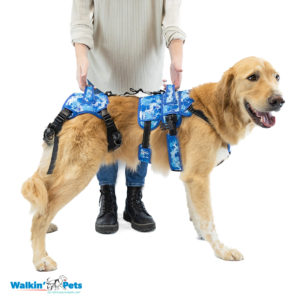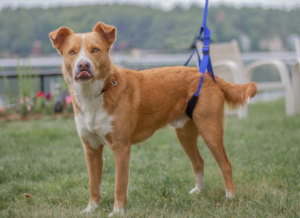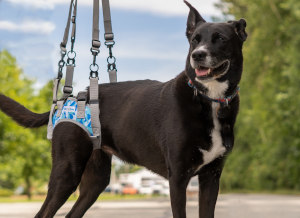
It’s not always easy to spot the signs that your dog’s mobility is changing. Many of the signs of mobility loss begin very slowly and may even seem like a normal part of the aging process. Whether your dog has a hard time standing up after a nap, is less active than they once were, or struggles to get up the stairs, it could indicate that your dog needs a lifting harness (and your help) to get around.
Let’s review a few of the common signs that your dog needs the support of a lifting harness.
1. Slow to Rise

Often, the earliest sign that a dog needs a bit of a hand is when an older dog tries to stand up after a long nap. Senior dogs may be slow to stand up or have difficulty standing up without assistance. It takes a lot of leg strength to push up off the ground. Standing up can be a real challenge for dogs whose legs are starting to weaken or those experiencing joint pain.
How a lifting harness can help:
A simple rear support leash can easily slip on your dog’s back legs while they are still lying down. Place a loop over each of the dog’s back legs and slide them up until they reach the top of your dog’s leg and gently lift. The harness will boost your dog to get up on all four legs.
2. Difficulty Climbing the Stairs

How your dog climbs the stairs can indicate a change in their mobility. Signs that your dog may need help on the stairs include:
- Unease on the stairs – may appear uncertain or avoids using the stairs
- Excessive panting or signs of exhaustion as the dog goes up the stairs
- Loss of balance or unsteadiness
- Inability to control descent – moves too fast or unable to stop
Your dog may give other cues as well. If a dog is feeling unsafe while using the stairs, they might hesitate to climb up or even refuse to use them altogether. This reluctance is usually because they do not feel confident about navigating the stairs safely.
Going down the stairs can be just as challenging. Many older dogs will pick up speed as they descend, almost as if they’re losing control. This can be incredibly dangerous, and your dog may not have the leg strength to be able to slow down.
How a lifting harness can help:
Using a supportive harness will allow you to control your dog while on the stairs. A lift harness will feature handles that can be used to lift and stabilize your dog on the stairs. This is helpful for aiding your dog as they go up and down the stairs. Look for a harness that supports the front and hind legs of your dog for the optimal level of control on the stairs.
3. Lagging on the Daily Walk
If you notice your dog slowing down or getting tired on longer walks, it could be an early indication that their legs are starting to weaken. As dogs grow older, changes in mobility are quite common, and we always recommend discussing any concerns with your veterinarian. If your dog seems to be unwilling to go on walks or appears to tire easily, it may be time to schedule a visit to the vet. Ignoring these signs could lead to more serious health issues down the road.
How a lifting harness can help:
Supporting your dog’s hind legs during a walk greatly reduces the strain and weight placed on aching joints. A rear support harness can be helpful for the early stages of mobility loss. It can also act as post-exercise support for dogs whose legs are shaky or weak after a long walk. For dogs that require a little more support or independence, a rear wheelchair may be the best option for longer walks and staying active.
4. Occasional Loss of Balance

It can be challenging for pet parents to identify when their dogs’ legs are getting weaker, as not all signs of weakness occur regularly. Some dogs may experience occasional swaying in the hind end, stumble, or lose balance periodically.
Look for these signs and consult with your veterinarian as it may indicate that your dog needs some occasional help.
How a lifting harness can help:
Using a rear harness and gently lifting your dog’s hind end can give them the extra support they need to stand up and walk without fear of falling over. This is great for quick trips outside as some dogs do lose their balance while going potty.
5. Healing from an Injury or After Surgery
When dogs have leg injuries, they often tend to favor the injured leg, which results in additional weight and strain on the healthy limb. This can cause problems for the dog’s overall health, as it puts unnecessary pressure on the unaffected limb. 
How a lifting harness can help:
When a dog is injured, using a harness for support can help them stand comfortably and distribute their weight evenly. This prevents them from putting too much strain on their unaffected limb and causing any further injury. However, it’s essential to consult a veterinarian before using a harness to ensure that it won’t hinder your dog’s healing process or cause any harm. Only use a harness on their recommendation and after they’ve cleared your dog to use it.

